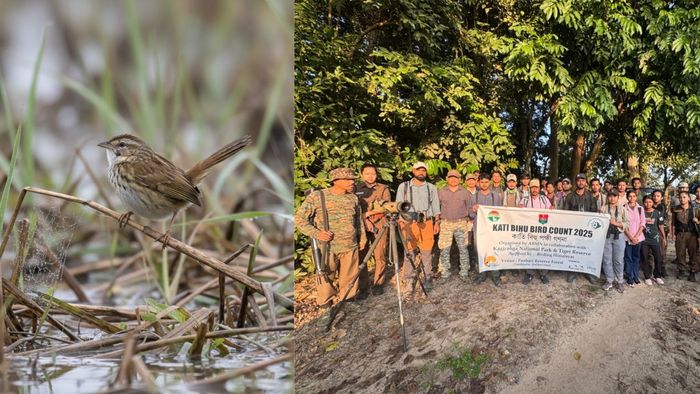Endangered swamp grass babbler among 146 species spotted at Kaziranga bird count
Kaziranga National Park recorded 146 bird species, including the endangered swamp grass babbler, in its latest count. Conservationists stress habitat protection to ensure the survival of these vital species

- Oct 19, 2025,
- Updated Oct 19, 2025, 8:44 PM IST
Kaziranga National Park has recorded two endangered bird species and 146 species overall during the Kati Bihu Bird Count 2025, with female forest staff participating in such wildlife surveys for the first time.
The count, held on October 18 across five locations in and around Kaziranga, drew 63 participants, including bird enthusiasts, students, researchers, and forest officials. The Assam Bird Monitoring Network organised the event with Kaziranga National Park & Tiger Reserve Authority.
Dr Sonali Ghosh, Field Director of Kaziranga National Park & Tiger Reserve, said the survey documented "two endangered species (Swamp Grass Babbler and Pallas's Fish Eagle), six vulnerable species (River Tern, Greater Spotted Eagle, Slender-billed Babbler, Lesser Adjutant, Great Hornbill, and Swamp Francolin), six near threatened species (woolly-necked stork, northern lapwing, blossom-headed parakeet, grey-headed fish eagle, spot-billed pelican, and river lapwing), while 132 species were of least concern."
The count recorded 1,919 individual birds across survey sites. Agoratoli Range reported the highest diversity with 89 species, while Gamiri and Panbari ranges each recorded 59 species. Panpur documented 55 specie,s and Laokhowa Wildlife Sanctuary registered 37 species.
Female forest staff participated actively in surveys at Laokhowa and Panbari, marking the first joint initiative by the monitoring network and Kaziranga to promote women's involvement in wildlife conservation efforts.
Survey teams fanned out across Panbari Range, Laokhowa Wildlife Sanctuary, two locations under Biswanath Wildlife Division at Panpur and Gamiri Range, and Agoratoli Range. Coordinators included Rofikul Islam, Samarjit Ojah, Neeraj Borah, Dr Ranjit Kakati, Rahul Sarmah, and Dadul Gogoi.
The survey documented notable resident and migratory species, including blue-eared barbet, bluethroat, grey-headed fish eagle, great hornbill, greater racket-tailed drongo, Indian spot-billed duck, jerdon's baza, lesser adjutant, ruby-cheeked sunbird, taiga flycatcher, chestnut-capped babbler, and blue-naped pitta.
"The presence of species such as the Swamp Grass Babbler, an endangered and habitat-specific bird, along with raptors like Pallas's Fish Eagle and Greater Spotted Eagle, highlights Kaziranga's ecological importance for both resident and migratory species," Dr Ghosh said.
The bird count served as a citizen science initiative focused on promoting community-based conservation while encouraging participation from local communities, particularly targeting women forest staff and younger generations. The findings will contribute to long-term monitoring of bird populations and understanding of habitat health in the Kaziranga landscape.
The Assam Bird Monitoring Network thanked all participants, coordinators, and the park authority for their support in making the event successful.